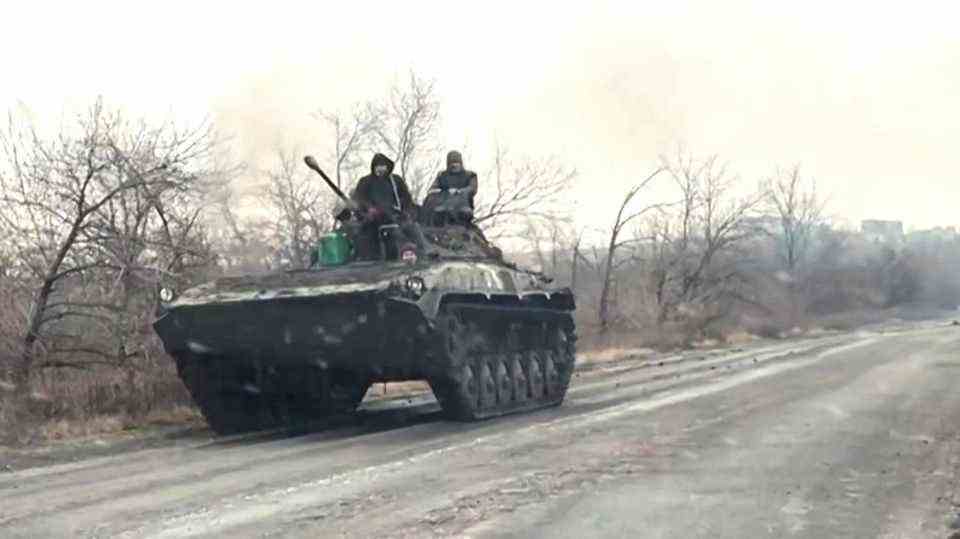Georgia, Chechnya, Ukraine
Always trouble with the ex (republic) – Russia’s conflicts with its neighbors
December 13, 1994, west of Grozny: Chechen soldiers fleeing from Russia’s attack helicopter, which threatens to explode.
© AFP Evstafiev / Picture Alliance
Battle zone ex-Soviet Union: Pro-Russia led successor states like Kazakhstan enjoy the support of Moscow. But anyone who renounces or flirts with the West draws the wrath of the Kremlin – an overview.
Exactly 30 years ago, the Soviet Union disintegrated into its components in a hut in the Białowieża Primeval Forest in what is now Belarus. On the morning of December 8, 1991, the presidents of the republics of Russia, Ukraine and Belarus sealed the end of their gigantic empire with the stroke of a pen. It had long since been economically run down, politically emaciated, incapable of reform and militarily exhausted. The disintegration began in March 1990, and in the end there were 15 individual republics. Some like that Baltic States, oriented to the west. Others like the republic Nagorno Karabakh or Transnistria never got beyond the status of a semi-official state structure. Most of them, including Kazakhstan and Turkmenistan, remained closely linked to the Kremlin. But some of them just won’t let Russia go – and that regularly causes conflicts.
1994: The first Chechnya war
The first muscle games began in the Caucasus with the struggle for independence Chechnya. Jokhar Dudayev, the first post-Soviet head of government in the area between the Black and Caspian Seas, pursued an explicitly anti-Russian policy. In doing so, however, he drew the wrath of Moscow. After an attempted coup in 1994 by a pro-Russian politician, the first of two Chechen wars broke out. Russian troops occupied the “breakaway” republic at that time. It was the first armed conflict on the former Soviet territory. In 1999, Islamists occupy Chechnya’s neighboring republic Dagestan, attacks followed in Russian cities. Vladimir Putin, head of government at the time, set himself the goal of militarily dealing with the troubled region.
The Kremlin-friendly autocrat Ramzan Kadyrov has ruled Chechnya since 2007. Although the situation has eased significantly, there are repeated clashes with Islamist fighters.
Kazakhstan is sinking into chaos – the images of a state of emergency
13 images
Another armed conflict with Russia also broke out in the Caucasus in 2008. Georgia was one of the few ex-Soviet republics, along with Lithuania, Latvia and Estonia, that did not become part of the successor structure of the CIS (Commonwealth of Independent States). With the end of the Soviet Union, the areas were declared in turn South Ossetia and Abkhazia independent of Georgia, to which the government in Tbilisi responded with a military operation. Russia later supported the two minor republics and recognized them as independent states. Georgia had previously moved closer to NATO and the EU. In the summer of 2008, the Russian air force began flying attacks on Tbilisi. In August, Russia finally withdrew its troops from the neighboring country.
Moscow continues to support South Ossestia and Abkhazia. However, only a handful of countries recognize them as independent states, including Nicaragua, Venezuela and Syria.
Putin makes Ukraine part of Russia
On the western border, too, Russia is having a dispute with a former Soviet republic: the Ukraine. Just recently, in an essay, Vladimir Putin quickly stripped the Ukrainians of their statehood and made their neighbors a kind of natural part of Russia. Historically, Russia emerged from the empire of the “Kievan Rus”. Today parts of Belarus, Ukraine and Russia are located in the area. In the tsarist empire, this gave rise to the idea of the “triune Russian people”. While some in Putin’s treatise read the announcement for the annexation of Ukraine, others understand it “only” as an indication that Moscow continues to regard Ukraine as its “zone of influence” – in the sense of imperialist power.
Ukraine was ruled by a pro-Russian government for a long time, but from 2004 began to orientate itself more towards the west. After the pro-European Euromaidan protests in 2014, independence movements emerged in Crimea and in the east of the country. The government in Moscow did not hesitate, sided with the separatists and first annexed Crimea and then supported the fighting on the border with Russia.
Since the end of 2021, Russia has been concentrating its military on its western border, around 100,000 soldiers are said to already be stationed there. The Ukrainian government and parts of the West now fear an open war. However, it is uncertain whether Putin is really planning something like this. Likewise, whether the Russian military aid that the Kazakh government has asked for thwarted Moscow’s possible Ukraine plans.
Sources:Deutschlandfunk, “New York Times“,”Frankfurter Allgemeine Zeitung“, Caucasuswatch.de; DPA, AFP



